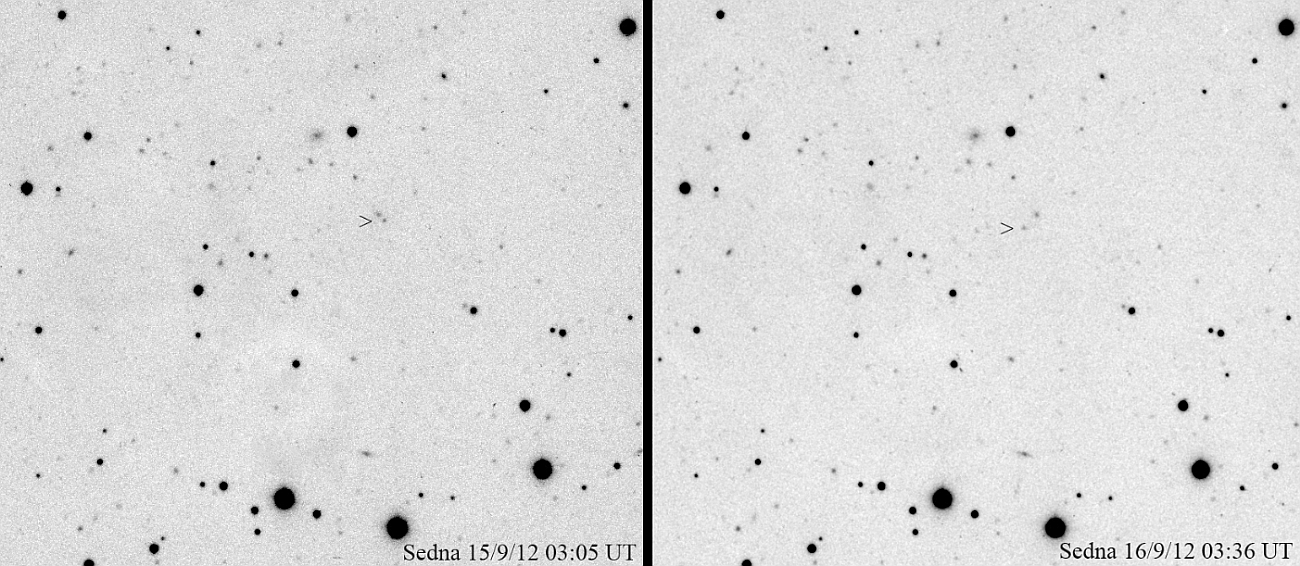
¿Es posible llegar a detectar con equipo de aficionado los tres objetos conocidos más distantes del sistema solar??
La respuesta es SI, es posible!!.
Estos objetos (exceptuando cometas de largo periodo y una sonda espacial) para 2012, son los siguientes TNOs :
136199 Eris a 96.52 U.A. de distancia del Sol. Todo lo que necesitamos para su detección es un cielo rural cuanto más oscuro mejor, un telescopio de al menos 10" (mejor 11" o 12"), un sistema de seguimiento que permita exposiciones de 60 min. sin errores de guiado, una cámara CCD, dos noches estables más o menos consecutivas con buen "seeing", unos pocos conocimientos y algo de técnica. Wikipedia
90377 Sedna a 86.78 U.A. de distancia del Sol
2007 OR10 a 86.66 U.A. de distancia del Sol.
Son cuerpos de muy poco brillo (Eris es el más brillante con mg. 18.7 pero los demás están ligeramente por encima de mg. 21!!) y tienen movimiento, lo cual complica todo más, pues su luz se reparte entre varios pixels.
Necesitamos elegir un periodo del año en el que estén lo más estacionarios posible (con su menor movimiento aparente) y elegir un tiempo de exposición que los haga visibles y a la vez, suficientemente corto para que no se desplacen durante la exposición y se difuminen en la imagen.
El enfoque tiene que ser perfecto todo el tiempo para disponer de la mayor profundidad de campo. Ojo a la primera mitad de la noche donde la caida de temperatura es muy notoria, pues nos obligará a reenfocar cada cierto tiempo, a menos que dispongamos de un sistema de enfoque compensador de temperatura.
Lo mejor es intentarlo en la segunda mitad de la noche, ahi seguramente podremos utilizar largas exposiciones sin tener que reenfocar entre ellas.
Lo demás consiste ya en saber donde se localizan y poner un montón de esfuerzo y paciencia en la tarea.
Están los tres en una zona cercana del cielo con lo que la tarea se puede completar en solo dos noches!! Suerte al que lo quiera intentar!!
Las fuentes de información utilizadas para su localización han sido:
NASA Horizons web-interface (http://ssd.jpl.nasa.gov/horizons.cgi#top)
Minor Planet Center (http://minorplanetcenter.org/iau/mpc.html)
Guide 8 Project Pluto.
Is it possible to detect the three most distant bodies of our solar system using amateur equipment?? These objects (with the exception of long period comets and a space probe) are, in 2012, the following TNOs:
136199 Eris at 96.52 U.A. from the Sun. All we need to detect them is a good rural sky, the darker the better, a high quality telescope al least 10" aperture (better chances using 11" o 12"), a good tracking system, capable of guiding up to 60 min. exposures without error, a dedicated CCD camera, two consecutive steady nights and some knowledge and skills. Wikipedia
The answer is YES, it is!!.
90377 Sedna at 86.78 U.A. from the Sun.
2007 OR10 at 86.66 U.A. from the Sun.
They are, no doubt, faint bodies (Eris, the brightest is mg. 18.7 but the other two are fainter than mg. 21 !!) and have apparent motion which adds much more trouble to the task.
We need to choose a time of the year when they move slower and we need to calculate an exposure time long enough to bring them into view in the CCD image but short enough so they don´t move during the exposure time and dissapear from view.
Focus is critical!! Focus has to be near perfect in order to have the deepest field of view. Be aware that in the first half of the night, temperature drops fairly quickly, and we are in need to refocus frequently, unless we own a temperture compensating focuser.
The best chance is to try during the second half of the night, temperature is stedier and we can take longer exposures without refocussing between them.
All three are relatively close, in the same area of sky so the work can be completed in only a couple of nights!! Good luck to anyone going for the challenge!!
The sources used to get their positions and useful information were:
NASA Horizons web-interface (http://ssd.jpl.nasa.gov/horizons.cgi#top)
Minor Planet Center (http://minorplanetcenter.org/iau/mpc.html)
Guide 8 Project Pluto.


Sedna, de mg. 21.1, fotografiado el 15 sep 2012 a la 03:05 U.T. y el 16 sep 2012 a las 03:36 U.T.
Son imágenes únicas de 60 min. de exposición.
En el Gif animado se muestra claramente su pequeño desplazamiento de 0.87"/hora, a lo largo de 24 horas.


Eris de mg. 18.7, fotografiado el 15 sep 2012 a la 01:27 U.T. y el 16 sep 2012 a las 00:56 U.T. desplazandose a 1.36"/hora. Como referencia comparativa de movimiento aparente, en el mismo periodo de tiempo podemos identificar en la imagen al tambien asteroide 24844 1995VM1, del cinturón principal, desplazandose casi 14 veces más rápido (17.08"/hora). Son imágenes únicas de 15 min de exposición.


2007 OR10, de mg. 21.4, fotografiado el 14 de sep. 2012 a las 22:53 U.T. y el 15 de sep. 2012 a las 22:57 U.T. Con una mg. de 21.4 y un desplazamiento de 1.36"/hora, se encuentra en el límite de visibilidad del instrumental empleado. Son imágenes únicas de 60 min. de exposición.